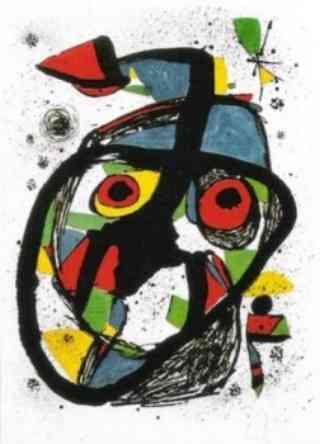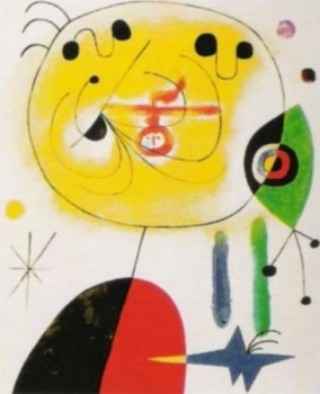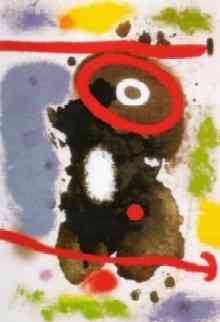
A ls diese Quartette in London erschienen, sandte ihm Clementi eine Kopie. Er öffnete sie und legte sie auf das Klavier. Am nächsten Tag, fährt Thayer-Forbes fort, besuchten ihn Felix Radicati und seine Gattin, Mme. Bertinotti und brachten ihm Briefe, da sie z. Zt. in England auf Tournee waren. Während des Gesprächs ging der Italiener zum Klavier, griff nach den Quartetten, und als er sah, was er in Händen hatte, rief er ungefähr aus: `Haben Sie die hier? Ha! Beethoven, wie die Welt sagt und ich glaube, ist musikverrückt; denn das ist keine Musik. Er schickte mir ein Manuskript davon und bat mich, sie für ihn durchzufingern.´ Ich sagte ihm, `Dass er sie doch gewiss nicht als Musik betrachte?´ —worauf er antwortete, `Oh, die sind nicht für Sie, sondern für ein späteres Zeitalter!´ ”DSM: So should we expect that Kronos Quartet will always give us a Kronos experience? Does the fact that the Miró Quartet chose to name itself after the Spanish surrealist Miró impart a surrealistic aspect to all of the music that they perform?

CMT: Well, look at the Miro Quartet’s repertoire: serialists and new music are not heavily represented. But, just the same, I think it’s possible to see in their accounts even of pieces like Shostakovich’s String Quartet No. 14 in F-sharp major, Op. 142 and Beethoven’s String Quartet in E minor, Op. 59, No. 2, a kind of relativism—and a self-referential and other-referential meta-awareness, a ‘regarding of the regarder of the music’.
DSM: By that you mean that you sense in their interpretations a kind of multilateral consciousness? —a consciousness that the Miró Quartet members themselves have of the act of their performance? —a consciousness of the fact that it is being performed for this audience of listeners; of the fact that the musical text was composed by another human being whose views are being rendered and reinterpreted; of the fact that the Quartet members have great latitude in executing that interpretation, just as the audience members have great latitude in their apprehending it; and of the fact that all of those processes and acts can themselves be the objects of observation and interpretation?
CMT: Exactly! And, despite that multifaceted awareness, their playing remains direct and spontaneous. There is the meta-music “about-ness” of their performance, which is consistent with their eponymous surreal Miró name, but it’s never self-conscious. I don’t know of anybody using the phrase ‘multilateral consciousness’ as you did. But that does capture what I meant to say. I suppose that many ensembles approach this to some degree, especially the more years they are together. But there is simply more of this, I think, in Miró’s style of playing than is usual for other quartets. My comment about ‘relativism’ was partly to say that this Quartet seems to invite the members of the audience into the music—the active and diverse and unrehearsed comprehension of the piece that each of those audience members bring to it. There may be a concert hall and a stage and they are up there and we are out here, but it is not so apparent with Miró Quartet playing where that boundary is—between the ensemble and the audience.

DSM: I’m reminded of Edward Cone’s concepts of immediate apprehension and synoptic comprehension. These concern alternative ways of apprehending musical texts and the structure—the beginning and the ending of each phrase and motive—also an awareness of the performance itself, the musical object, and an awareness of the audience and performers and composer, musical subjects.
CMT: I’m still wondering about the Miró Quartet’s choice of the surrealist eponym. Maybe they just admired Miro’s paintings and they did not intend that the name should have any deeper and predictive significance for their selection of repertoire or the style of their interpretations of the works that they perform. Can Beethoven or Shostakovich—music that’s engaging and demanding and powerful and disturbing—be connected in any valid way with the surrealism movement?
DSM: Each was, in his own time, something of an iconoclast—but iconoclasm and breaking the mould of convention in one’s own time is not by itself enough to make the label ‘surreal’ stick. And Dalí-like drooping-clockface distortions are not by themselves enough to make it stick. If we find in a composition explicit reference to or quotation of the prevailing conventions with the express intention of distorting them or breaking them or exposing the absurdity of the assumptions of the convention referred to, though, then that’s strong evidence in favor of a surreal stance. Webern is one who understood that the new wine had to be put in newer, smaller bottles—compared to Schoenberg and others, who were less concerned with locality of reference. Webern’s sparse textures remind me of Mondrian’s paintings and the paintings of other minimalists and cubists. But there are days when Webern seems much too abstract and cerebral and I rush back to the unmediated passion of Van Gogh and early Beethoven.

CMT: Shostakovich’s String Quartet in F-sharp major, Op. 142, is maybe the most accessible of his late quartets. The opening theme—the repeated F sharp on the viola over the simple theme on the cello—is not so innocent and naïve as it first appears, and it’s transformed into something far more serious. Miró’s interpretation of it is a journey of discovery, plumbing various contexts for these themes. The cello recitative leading into the extended coda begs the question of whether it was an introduction to the slow movement or a summation of the opening movement. Their playing of this suggests Miró’s own awareness of these manifold significations—the perplexity and simultaneous validity of all of them, the situatedness and subjectivity of each of them—and this comes back to the appropriateness of attaching the ‘surreal’ label to the treatment of it.
DSM: The Adagio in this Shostakovich Quartet exhibits a kind of minimalism. The violin solo in D minor joined by the cello in the first of several passages of counterpoint between the instruments—s this discursiveness compatible, do you think, with the label surreal?
CMT: Maybe, although that would be pretty weak evidence, I think. Many of Shostakovich’s quartets have movements that link or refer to each other. Here it’s the Adagio that connects to the finale, and the chromatic and passionate finale gradually calms until the cello leads the quartet to a serene ending in the tonic key. There’s a self-referential quality to that process, and to the connection between the Adagio and the finale—the ending as ending—that’s consistent with a post-modern or surreal gaze.
DSM: What about the Beethoven String Quartet in E minor, Op. 59, No. 2? Is Miró Quartet’s account of that piece in any sense ‘surreal’?
CMT: Well, recall Beethoven’s famous remark to Clementi about this piece. Beethoven told him to back off—he was writing for posterity! When Clementi criticized the Op. 59 quartets, Beethoven responded, “Oh, they are not for you, but for a later age.” (blockquote above)

DSM: The second quartet of the group has the Scherzo with its syncopations and unconventional accents that beg the question of rhythmic continuity. Basil Lam calls it a ‘non-scherzando scherzo,’ humorless, belying the scherzo form. The Trio quotes a Russian ‘slava’ theme from Ivan Prach’s collection of Russian folk tunes. In that borrowing or reference we have, I think, a bit of evidence of surrealism. It’s not merely a quotation or borrowing. It’s a distortion that calls into question the assumptions of the folk melody—calls into question the conventional perception of Russian folk culture, the real Russians whose music was being collected by Prach, and the cultural apparatus that was bringing these musical specimens to the rest of Europe somewhat in a bell-jar.
CMT: One composer who was associated with the original surrealist movement was Satie. I don’t think he was an official member, but he was in Paris at the time and often worked in conjunction with some of the artists, like Cocteau. The futurists in Italy were more musically inclined, and I’ve heard a CD that has some of their music as well as a recording of Appolinaire reading his ‘Le pont Mirabeau’ on it. Some modern musical groups tout themselves as being surrealist, but usually these are poseurs. Satie was not really a surrealist—at least he himself never sought that label or inclined in that direction. If he’s associated with any movement it would be the late impressionists, with whom he used to hang out in Paris bars. He doesn't even match historically—he is before the Dada surrealists of the early period.
DSM: Other composers linked with surrealism were Bohuslav Martinů and Andre Souris. Also Edgar Varese, who expressly said that his work ‘Arcana’ was drawn from a surreal dream sequence. Souris had a relationship with Magritte, and he worked on Paul Nougé's magazine, Adieu Marie.
CMT: Oh, and Pierre Boulez wrote a piece called ‘Explosante-fixe’, which was inspired by Breton’s famous mad love.

DSM: Breton in 1946 responded negatively to the subject of music with his essay Silence is Golden. But later surrealists have been interested in music and acknowledged parallels to surrealism in, say, the improvisation of jazz and the blues. Paul Garon is a surrealist whose books addresses this.
CMT: It’s an axiom of post-Romantic thought that the artist must remain true to the requirements of the material, but Adorno interprets this axiom to mean that material isn’t some inert substance to be transformed by the artist, but is instead something that’s inherently historical: “material is what artists manipulate: everything from words, colours and sounds through to connections of any kind. . . Forms, then, can also become material.” These claims are developed by Adorno in an important correspondence in the late Twenties and early Thirties with Ernst Krenek. Krenek saw the composer as an autonomous creator with absolute freedom to select material, but Adorno responded that their choice was restricted by historical possibilities and possibilities that are constrained by the audience.
DSM: It’s a stretch to see this in Beethoven, except inasmuch as he was so far ahead of his time. In the early 21st century it’s impossible to write without irony in the style of Brahms, let alone Mozart. Tonality, for instance, no longer has the meaning it had for them. For Adorno, music of the past is understood from the contemporary position and all of its associated constraints and demands. A ‘tonal conservative’ composer, by contrast—one who rejects modernism or serialism—believes that they can reject these demands, and continue using tonal or classical forms and language without irony. Shostakovich exemplifies this. But Adorno dismissed such conservatism as inauthentic, and allows re-use of tonal material only in the form of what he calls ‘surrealist music’, as it is by Krenek. Such music cannot be restored to some primeval state, some objective, rational, single meaning or signification. Instead it creates a new unity from historical fragments: “… surrealist composing makes use of devalued means… as devalued means, and wins its form from the scandal produced when the dead suddenly spring up among the living… a montage of the debris of that which once was.”
CMT: This technique of pastiche-like surreal reference and borrowing is a routine of postmodern chamber music—examples are Ligeti and Thomas Adès, Weill, Tippett, Rochberg, Rihm and Saariaho.
DSM: By this Adorno means that elements which are not meaningful in themselves are organized into a meaningful structure: "Music resembles language in that it is a temporal sequence of articulated sounds which are more than just sounds. They say something, often something human. The better the music, the more forcefully they say it. The succession of sounds is like logic: it can be right or wrong. But what has been said cannot be detached from the music. Music creates no semiotic system". Adorno gives the example of musical affirmation, "the judicious, even judging affirmation of something that is, however, not expressly stated." Adorno believes music constantly poses riddles that it never answers—but he insists that this is true of all art. What the artwork says is not what its words say, and so the cases of music and literature are not so distinct: "No art can be pinned down as to what it says, and yet it speaks!"

CMT: Adorno often compares composers to philosophers, and describes their work in philosophical terms—he links Beethoven’s dialectic of sonata and quartet forms with Hegel’s dialectical method. He compares Hegel’s emphasis on the ‘labor of the concept’ with the way that motivic or thematic material must be worked on progressively, not just recapitulated. So Beethoven continues motivic development even in his recapitulation sections. It’s not sufficient simply to make thematic allusions or references; they must be altered or transformed somehow. That’s clearly an alignment with surrealist ideas. And that’s part of what we hear in Miró.
DSM: André Breton’s Surrealist Manifesto of 1924 and the publication of the magazine La Révolution Surréaliste marked the beginning of the movement as a popular phenomenon. In the manifesto of 1924 Breton defines surrealism as “pure psychic automatism.” Automatism meant spontaneous creative production without conscious moral or aesthetic authorial action or deliberation or self-editing. By Breton’s own admission, though, this was an incomplete definition. Pure psychic automatism, or free-association, was only part of it. The more expansive concept was to reveal the real functioning of thought, including all of the subliminal processes involved in it. Dictation of thought in the absence of all control exercised by reason, outside of all aesthetic and moral preoccupations.

CMT: Surrealism in philosophy and aesthetics seems more concerned with covert associations, with the ubiquity and pervasiveness of dreams, and with the disinterested interplay of thought. Rationality seeks always to explain; it’s preoccupied with cause and effect, with inductive and deductive logic. But Surrealism is casuistry; it’s preoccupied with specific cases, with instances that are associated but without causality or determinism.
DSM: Breton and Philippe Soupault wrote the first ‘automatic’ book, Les Champs Magnetiques, in 1919. Later, automatic drawing was introduced by André Masson, and automatic drawing and painting, as well as other automatist methods, such as decalcomania, frottage, fumage, grattage and parsemage became significant parts of surrealist practice. Games such as the exquisite corpse also assumed a great importance in surrealism. Although sometimes considered exclusively French, surrealism was in fact international from the beginning, with both the Belgian and Czech groups developing early. The Czech group continues up to today. In fact, some of the most significant surrealist theorists and the most radical of surrealist methods have come from countries other than France. For example, the technique of cubomania was initiated by Romanian surrealist Gherasim Luca.
CMT: Automatism, including improvisation and collage are the primary techniques of musical surrealism. Max Paddison defines surrealist music as that which “juxtaposes its historically devalued fragments in a montage-like manner which enables them to yield up new meanings within a new aesthetic unity.”

DSM: So while it’s related to Dada, from which many of the initial members of the surrealist movement came, surrealism is very much broader in scope. And while Dada was a negative response to the First World War, surrealism has a more positive worldview—that the world can be changed and transformed into a sphere of freedom, love, and art. The Miró Quartet’s performances embody that positive stance and thoroughly fresh musical ideas, regardless whether you find any evidence of surrealism in them. They’re performing in Kansas City on Friday, Saturday, and Sunday this week.
- Adorno T. Philosophy of Modern Music. Athlone, 2003.
- Adorno T. Philosophy of New Music. Univ Minnesota, 2006.
- Adorno T. Essays on Music. Univ California, 2002.
- Adorno T. Beethoven: The Philosophy of Music. Stanford Univ, 1997.
- Bergmark J. Wild Music. Surrealistgruppen, 1993.
- Broadhurst S. Liminal Acts: A Critical Overview of Contemporary Performance and Theory. Cassell, 1999.
- Cone E. Musical Form and Musical Performance. Norton, 1968.
- Frizzell D, Mandeville J. Indeterminate Moments w/ John Cage. LodeStone, 1998.
- Garon P. Blues and the Poetic Spirit. City Lights, 1996.
- Kaeseberg N, "Partch: An ‘unheard of’ music", in Rosemont F. Surrealism and its Popular Accomplices. City Lights, 1980.
- Kelly B, Levy S. Dangerous Music: Belgian Theories of Musical Surrealism. Aura 1996 Spring;72-85
- Lanza J. The Sound of Cottage Cheese. Performing Arts Journal 1991; 42–53.
- Lebaron A. "Reflections of Surrealism in Postmodern Musics", in Lochhead J. Postmodern Music/Postmodern Thought. Garland, 2000.
- Levy S. Scandalous Eye: The Surrealism of Conroy Maddox. Liverpool Univ, 2003.
- Miró Quartet website
- Miró Quartet. Beethoven Quartets. (Vanguard, 2005.)
- Paddison M. Adorno, Modernism, and Mass Culture. Kahn & Averill, 2004.
- Paddison M. Adorno’s Aesthetics of Music. Cambridge Univ, 1998.
- Spariosu M. Wreath of Wild Olive: Play, Liminality, and the Study of Literature. SUNY, 1997.

No comments:
Post a Comment